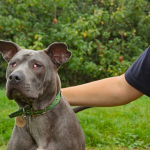
Dental care for your pet
Being proactive and having a great home care routine between regular dental checks, you are helping to keep dental disease at bay.
Here at the Cotswolds Dogs and Cats Home, we can celebrate the many benefits this will have of our beloved furry friends, and give you some tips on how to keep them in tip top health.
Keeping your cat’s teeth clean
It might surprise you to know that disorders of the teeth, jaw and mouth are unfortunately one of the most common issues that cats suffer with.
It doesn’t help that cats tend to be great at hiding signs of discomfort and pain, but to ensure your cat has the best quality of life it’s a good idea to establish a good dental care routine as soon as possible.


From around six months of age, cats have 30 sharp teeth which are used for chewing food, catching prey, and defending themselves. It’s common for kittens to experience mild discomfort, gum inflammation and even bad breath as they’re teething, but if you notice any of these signs in your adult cat it’s a good indicator that they’re having problems with their teeth.
Other signs to look out for are:
- Drooling
- Bleeding gums
- Reduced grooming activity
- Reduced appetite
If your cat displays any of these symptoms, it’s best to see your vet as soon as possible.
We recommend regular health checks with your vet, where they will examine your cat’s mouth and ensure their teeth are strong and healthy.
Tips for general dental care:
- Provide your cat with a healthy and balanced diet and avoid feeding them sugary treats.
- Kibble complete diets can help keep your cat’s teeth clean as the crunchy kibble can help remove plaque buildup.
- Brush your cat’s teeth! Ideally, this should begin at a young age, so they grow up getting used to having their teeth touched. Buy specialised cat toothpaste, and a toothbrush designed for cats. Begin by putting your cat’s toothpaste on your finger and offering it to them to lick, and slowly build up to gently pulling back your cat’s lips and touching their teeth, and finally using the toothbrush to brush the tooth surface and the gumline. If you’re unsure, you can ask your vet to show you how to brush your cat’s teeth correctly.
Keeping your Dog's teeth clean
Similarly, to cats, it’s important to keep your dog’s teeth healthy, as neglecting this can lead to plaque build-up and dental problems.
The best way to do this is to:
- Feed your dog a balanced and varied diet, which includes dry food — this has a mild cleaning effect on the teeth.
- There are several brands of healthy dental chews – ask your vet for recommendations.
- Brush your dog’s teeth! If possible, establish this routine when they’re a puppy and brush their teeth regularly to get them used to it.
- You can start by having your finger near your dog’s mouth, and then slowly introducing a suitable toothbrush and dog-friendly toothpaste.

Some breeds have different jaw alignments, and brachycephalic dogs (like pugs, French bulldogs and chihuahuas) tend to suffer more with crowded teeth, which can make cleaning tricky. If you’re finding things difficult, ask your vet first.
Taking the precautions above will give your dog the best chance of avoiding dental disease, but ensure you look out for the signs nonetheless:
- Bleeding gums
- Bad breath
- Visible deposits and discoloration in the teeth
- Your dog may also refuse food or have difficulty eating.
If your dog has any of these symptoms, please contact your vet.
If you are ever unsure please do speak with your vet.

Categories
- Appeals (4)
- Events (7)
- News & Updates (60)
- Happy Tails (22)
- Past Appeals (80)
- Past Events (88)
- Support & Advice (43)
- Challenge Events (2)
Recent Posts
Related posts


Exploring the Cotswolds with your dog: Countryside, charm & canine adventures

Petplan’s Animal Charity Team of the Year!

Unusual Dog Names

To report cruelty or an animal in distress call 0300 1234 999












































































